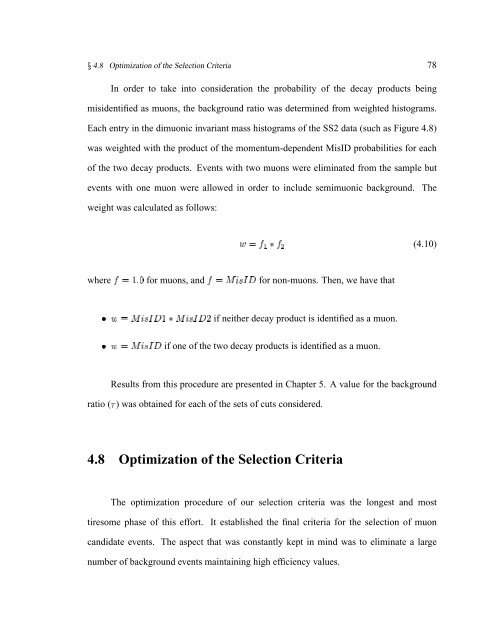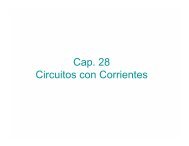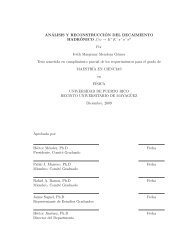A Search for Rare Decay D0 --> mu+mu - High Energy Physics UPRM
A Search for Rare Decay D0 --> mu+mu - High Energy Physics UPRM
A Search for Rare Decay D0 --> mu+mu - High Energy Physics UPRM
You also want an ePaper? Increase the reach of your titles
YUMPU automatically turns print PDFs into web optimized ePapers that Google loves.
4.8 Optimization of the Selection Criteria 78In order to take into consideration the probability of the decay products being”misidentified as muons, the background ratio was determined from weighted histograms.Each entry in the dimuonic invariant mass histograms of the SS2 data (such as Figure 4.8)was weighted with the product of the momentum-dependent MisID probabilities <strong>for</strong> eachof the two decay products. Events with two muons were eliminated from the sample butevents with one muon were allowed in order to include semimuonic background. Theweight was calculated as follows:Ü —žÝ Þ¥ß}Ý4à (4.10)where Ýi—á£<strong>for</strong> muons, and Ýi—<strong>for</strong> non-muons. Then, we have that¿ÀÎãâ?äeå&æÎãâ?äeå&æΞâêäeåÕæ— çèÜÎãâ?äeå&æ— çèÜ£éߥ if neither decay product is identified as a muon.if one of the two decay products is identified as a muon.Results from this procedure are presented in Chapter 5. A value <strong>for</strong> the backgroundratio (• ) was obtained <strong>for</strong> each of the sets of cuts considered.4.8 Optimization of the Selection CriteriaThe optimization procedure of our selection criteria was the longest and mosttiresome phase of this ef<strong>for</strong>t. It established the final criteria <strong>for</strong> the selection of muoncandidate events. The aspect that was constantly kept in mind was to eliminate a largenumber of background events maintaining high efficiency values.






